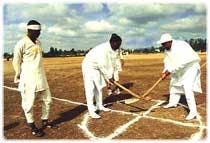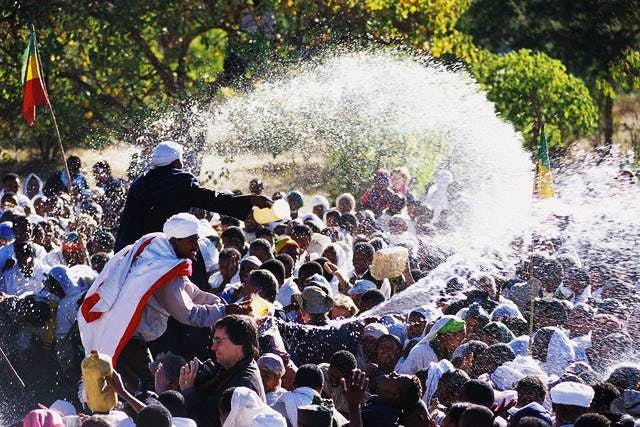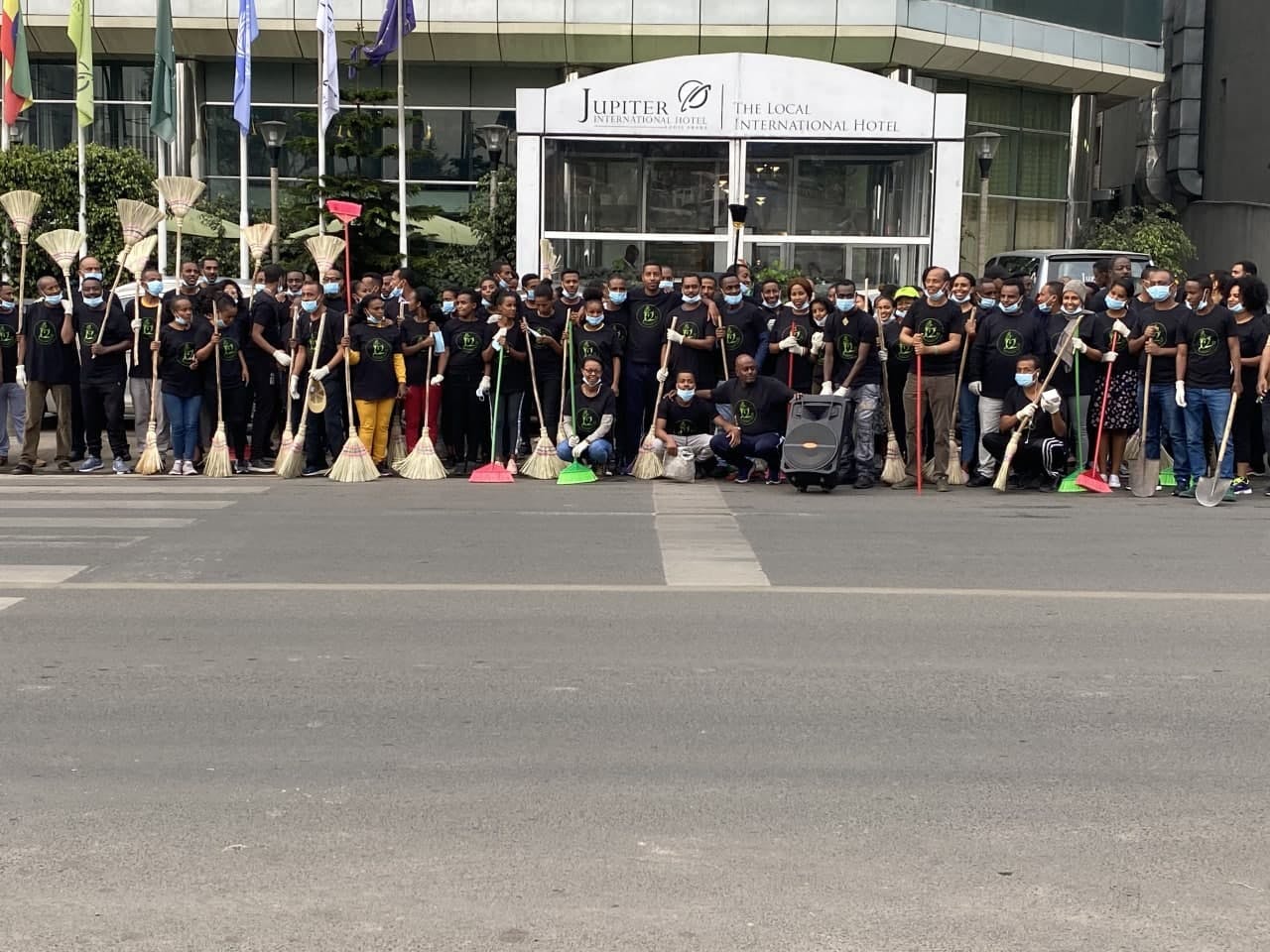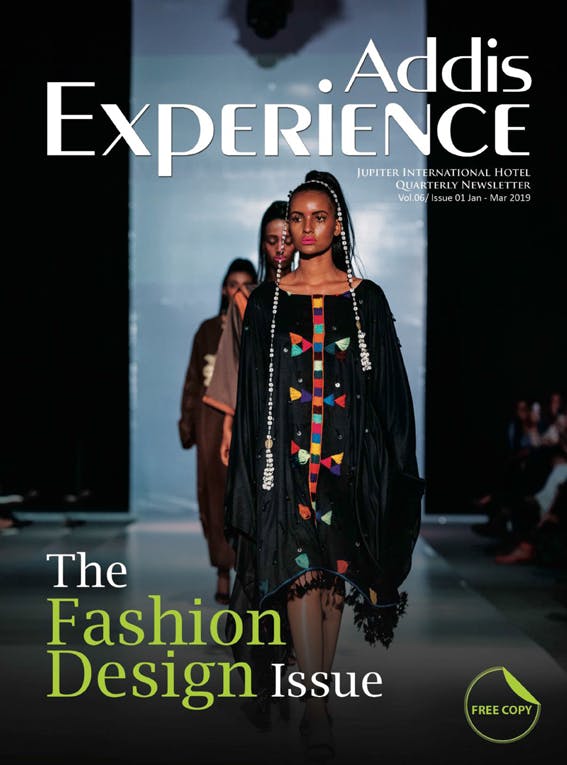Our Magazine
Grab a hard copy of our quarterly magazine at any of our hotels and Subscribe to get our the next edition in your Inbox.
Or click on any off the issues to get your Online copy Of Addis Experience.
Icons of change
Bored Cellphone is a photography platform on Facebook created by a young architect Fikreselassie Tsegaye aka Shady Deeds, in 2018 Addis Ababa. A mobile phone photography group, it works as a laboratory for young amateur photographers and artists. Facebook has placed the platform in the top five of sub-Saharan Facebook groups under its title - Icons of Change.
The motto for Bored Cellphone Addis Ababa is ‘let’s take a step back!’- a step back for the sake of the future, and two steps ahead. The idea is to question the very basic requirements of photography:
Why a studio?
Why a professional camera?
Why be too busy to take photographs?
The initiative behind the platform goes on to state: “You could be bored, you can use your cellphone as your studio; you can go as wild and as open as a city...Why Not?”!
Often, people do not practice their photographic hobby because they do not have a professional camera, a photography studio, or time to spare. This means that they do not give themselves a chance to try something in which they believe they may excel. There are also people who do not know they possess a talent for photography because they simply have not tried it. Therefore, Bored CellphoneAddis Ababa took a step back and rather than contacting known photographers or those with a studio, reached out to those who wish to build community, individuals who have been ‘out there’ getting on with it. For these photographers, the platform is made available, a place where they can post their work, whatever it might be.
The creators of the platform challenge members to put down their cameras and use their mobile phones. The message has spread quickly, and on a daily basis, people are sharing and accepting the platform, and growing with it. Workshops have been provided and the platform innovators are discovering awesome photographers to feed the Ethiopian arts industry.
So the idea of the project is to build an arts- conscious community that participates, experiences, and encourages, new perspectives and new talents, to find expression and to experiment. The basic aim of the Facebook group as a starting point is to create a platform for amateur photographers. The simplicity of the initiative goes further in that there is no need to set a calendar to practice; one can be anywhere and take photographs at any time. In addition, people do not have to be worried about having the perfect camera or gear, and thus they can share their perspective in the community.
We all know that smart phones today have quality cameras installed. The idea for this project is to use ones smart phone creatively and think outside of the studio. Addis is a city with a huge variety of locations and activities, and citizens with breath-taking perspectives. Think about it, even with the best ‘kit’ it might take a lifetime to document a city. Bored Cellphone Addis Ababa has created a community made up of many ‘cameraheads’ who offer myriad visual angles of the city in all its phases.
To create a community that can build a photography archive of our city only takes a mobile phone. Imagine that!
Bored Cellphone Addis Ababa is 50,000 members strong and growing, with more than 60 000 pictures posted in just one year! The platform has already become an important picture archive.
Out of the current initiative will roll more photography workshops, exhibitions, and a magazine called Dewel.
If you want to join the community, contact us at
251920348610 boredcellphone@gmail.com

Ethiopian Christmas and YegenaChewata
Ethiopian Christmas or Genais one of the country’s most colorful holidays. Ethiopian Christmas falls on January 7 in the Gregorian calendar which corresponds to Thahisas 29, or28, when it is a leap year, Zemene Yohannes - year of John –in the Ethiopian calendar. Thahisas corresponds to December, but unlike December, Thahisas is the fourth month of the Ethiopian year as the year begins in September.
The celebration of Ethiopian Christmas is marked by activities such as horse racing and authentic folk dancing. In Lalibela, Gena is celebrated in particularly appealing ways because the birth date of King Lalibelais is celebrated simultaneously. In the rural areas across Ethiopia, a popular game which looks like hockey, but is in fact typically Ethiopian, is conducted between two youthful teams. The game is named after the festival and is called YegenaChewata.
YegenaChewata has always been known as the ‘game for all’, cutting through social strata. The understanding is that the master and subordinate divide has no room in the game. The game is played by all, and there should be no feelings of revenge and intimidation by the losing side. On the field, all contenders are equals, and they expected to display their talents and skills to the best of their ability.
YegenaChewata is played with a crude hockey stick - gena, and a small wooden ball - rur. Men and boys participate. Players dress in short pants cut to above the knee, and wrap a cloth - dig -around the waist, when they play.
Leaders for the two competing teams are chosen. Then two pairs of players will give themselves secret names. The secret names will be given to the team leaders who will assign players to the two groups using the secret names. The players will join one of the teams only if the teams are from the same villages or kebeles (town district).
There are nine players and a goal keeper in a team, and a total of ten teams compete in a gena tournament. The game of YegenaChewata is all about scoring a goal by hitting a rur that is made either of plastic or of wood, and preventing the rur from finding its way into the goalmouth. Players kick and pass the rur to one another, in order to score a goal.
The game of YegenaChewata is played differently in different part of the country: There is Qurquse: where players can follow the rules and regulations of the game according to their duty and responsibility, nothing is fixed. But when playing qurquse-style, kicking the rur is strictly forbidden. The player may only dribble the ball.
Then there is Muche where the rur is pushed in a sweeping-like action. Here players can sweep opponents’ feet together so contenders have to be able to jump high to protect them from injury!
Afsomelgat and Kelbomelgat are more complex forms of play with slight differences. Every player can show off his own individual talent and skill. There are no rules about moving the rur. Players can use any kicking style as long as no fellow players are harmed. The Afsomelgat form of play is generally played on holy days.
A team is required to to give a list of 15 players to the leaders, of which 5 are substitutes. A captain is elected. The smallest number of players allowed to play is seven. A team will register their substitutes and replace players, one by one or all at one time, as required. Once a player is substituted he will not be allowed to return to the field. The captain is the person in charge of reporting to the referee when the rur is offline. He is also the person who ensures players play fairly, and maintain sporting codes. So that others can easily identify the captain, a signifying symbol will be placed in his hand.
It is expected that the outfits worn by the teams should reflect the culture of the areas or regions that they are representing. A given team may have two types of outfits of different colors and designs to get themselves registered. As a rule, the outfits are not permitted to be identical. If, accidentally, the attires are similar, the host team is asked to make a change. If both teams are not from the locality where the tournament is held, they change their outfits by mutual agreement. If no agreement is reached, they will draw lots. Players are also expcted to wear appropriate shoes, and to cover their forelegs so as to minimize leg injuries. Adornment by cultural or modern jewelry is not permitted. Goalkeepers guard against injuries by wearing gloves as well as leg and body covers. All players must be easily identified by a conspicuous number on the front and back upper body.
Referees and coaches have specific duties and responsibilities. Referees have the responsibility of managing the game and identifying the winning team, controlling time, and other features of the game. Sixty minutes is allotted to each game, divided into two halves, with a ten minute break in the middle. Injury time for the first and second half will be added before the break, and before the end, respectively. Coaches bear the responsibility of developing each player’s potential, encouraging excellence in execution, and providing positive feedback to the players.
The winner of the YegenaChewata cultural game will be identified by the greatest number of goals scored at the end of the second half. A twenty minute of extra time will be added if there are equal goals scored. The knockout period works much like it does in soccer.
YegenaChewata was particularly popular during the reign of the great feudal lord, Emperor Menelik. There is a saying: Begenna Chewata Aykotum Geta that means ‘the master will not hold grudges if he gets hurt while playing Genna’. The tournaments marked a time when different classes of society were able to come together to experience sporting rivalry and put their accepted place in the community aside.
As in the past, after a tournament, the victorious team will celebrate by processing at evening time, through the village, heroes of the sporting festival.
Merry Ethiopian Christmas!!
@Addis Experience 2017
Photo creadit http://ethiopedia.blogspot.com/

ETHIOPIAN EPIPHANY
Ethiopia, in the Horn of Africa, is a rugged, landlocked country split by the Great Rift Valley. With archaeological finds dating back more than 3 million years, it’s a place of ancient culture. Among its important sites are Lalibela with its rock-cut Christian churches from the 12th–13th centuries. Aksum is the ruins of an ancient city with obelisks, tombs, castles and Our Lady Mary of Zion church and there are also so much more old cultural destinations and holidays among them, Timket ‘’ጥምቀት’’ Ethiopian Epiphany is one of the oldest and colourful festival/celebration that the country hold and keeps it for centuries.
‘ጥምቀት’, ‘Timket’ Ethiopian Epiphany is the greatest festival of the Ethiopian year, falling just 2 weeks after Ethiopian Christmas. Ethiopian Epiphany (Timket) has several colourful stories. This annual religious celebration of Ethiopian Orthodox Church is not just another event for the believers to be thankful and get more blessing. From the very beginning, the celebration has unique and very attractive way of festivity. Though its primary implication is religious, it is an event people from different spiritual background enjoy and celebrate equally. Timket celebrates the baptism of Jesus by John the Baptist in Jordan River. To memorize this biblical chronicle, the Tabots of each church (a replica of the Arc of the covenant) representing all the saints will be out of their secret holy houses (Bete Mekdes), and make a slow procession to the nearest river. There are about 44 saints celebrated by Ethiopian Orthodox Churches, and each one of them has their own replica of the Arc of Covenant. Under the dogma of the church, the Tabots have extreme relevance than the building of the church. Watching the Tabots out of their Bete Mekdes, where only few have an access, and see them on the streets is one of the most valuable religious moments for the believers. Many follow the Tabots from the church to their respective destination. In Addis Ababa, most Tabots end up at Janmeda, a big space around Sidest Kilo.
The Tabots start their journey on January 19/20, in the afternoon. This day is called Ketera, which is the beginning of the almost three days of colorful Timket celebration. Once the Tabots reach their destination, most followers do not go home. Instead, they spend the night praying, singing and dancing. The event is one of the biggest public festivals where everyone from different ages and social group takes equal participation. Especially traditional dances and songs of all kinds and the modern Harmonica music with dance are at the top of the all-night party.
The next day, the prayers in one side and the dance and music on the other will continue. The mass takes place in the morning and the religious fathers pray on the water to make it a holy water and sprinkle it on the believers. Everyone will fight to touch the water and share the blessing. Religious leaders speak the words of god. Finally, when its time, those engaged on the prayers and others busy using the event as a party will follow the Tabot to its respective churches. People will go in a direction where the Tabot is to their nearest church.
For many, what makes Timket very attractive is its religious ceremony that is calm, with beautifully arranged prayer melody (Kidase). Colourful costumes of the religious leaders, priests, and everyone engaged in the making of the ceremony, the shine and impressive umbrellas to protect the leaders and the Tabot from the sun and the classical gowns makes the ceremony the most beautiful celebration of all time. The slow movement of the Tabot, that is covered with incredibly designed wrap, and the respect and gratitude it gets in its entire journey also make any stranger choose not to be anywhere but there.
Young and Passionate members of church sing, with their special costumes mostly with traditional tunes, delight the whole journey of the Tabot, with original Orthodox Church musical instruments like Tsenasel. To give their sound novel and conventional tune they use the traditional Ethiopian drum (Kebro), with incredibly big size. From January 19-20, for two days, they follow the Tabot all the way with their sound. On Temiket, everything looks and smells very original, unique and beautifully traditional, making the event one of the few occasions to have an insight of the real Ethiopia, which is rich in culture and tradition.
Most Tabots will be back to their churches holy house by the evening of January 20. Except those who decide to follow the Saint Michael Tabot, everyone says good-bye and go home praying to be there at the same time and at the same place next year to follow the Tabots. Saint Michael remains to be the only one to go home on January 21 because it has its own monthly celebration on the same day. That makes, in some areas, Temiket a three-day celebration.
In addition to the direct participants of the celebration, watching the followers of Tabot is another unique experience. Everyone takes considerable care to choose his or her outfit for Temket. It is a rare opportunity for many to use the beautiful and attractive traditional cloths. There is even a saying that underlines the importance of dressing well for Temket. 'Letemket yalehone kemis yebetatese,' or meaning 'a dress if not for Temiket has no use.' This is because the remarkable and colorful celebration of Timket especially in the past, in addition to its religious significance, is an occasion where young people choose their future wives and husbands. It is an opportunity to meet and engage with stranger opposite sex without adult supervision. The parents understood this trend and let their mostly teen-age children to be free and engage in the music and dancing without restrictions. Though it does not happen in our modern day, stories have it that the boy will throw a lemon on a girl he wishes to dance with to let her know he is interested. If she feels the same, then they will get down with traditional Eskesta until they get tired. The talk will take place after that.
Timket was celebrated last week with its colorful glory and traditional essence. However, young people did not throw lemon at each other. They joke about lemon getting very expensive, but the real reason behind is the fact that they can just get a phone number of a girl or a boy they are interested in.
Save The Day, Don’t Miss It,
Timket Festival Is in All Over Ethiopia
Original Article by Seble Teweldebirhan, Ezega.com
Edited by Addis Experience team

We Commemorate our Twelve Year Anniversary with
Three Major Initiatives under the Banner
“CELEBRATING PURPOSE”
April 11 and May 28, 2008 are two memorable dates for the Jupiter Family. These dates mark the launching of our two portfolios at Cazanchise and Bole. To commemorate our twelve years in business and as means to rekindle unity, social bonding, and belonging, among the JIH team, three major initiatives were launched under the banner ‘Celebrating Purpose’ at a gathering held at the Hyatt Regency, December 24, 2019.
Three initiatives were launched: Working for the community(blood donation, clothing donation, city cleaning); Instituting social clubs (building team capacity, JIH Book Club, Toastmasters, Retracts[Rb1] ,); Tena Yist’legn Hospitality Services (an institution for practical knowledge sharing for hotel and tourism education based in Addis Ababa).
To effectively implement these three initiatives, forty-eight teams of six were constituted made up of staff whose tenure at JIH exceed five years. Each team was led by a senior manager and a middle manager facilitator and given the following names: Teams ‘Mahiberawi’, ‘Andinet’, ‘Fiker’, ‘Yenenet’, ‘Medemamet’, and ‘Mekebaber’.
Ten Jupiter work culture pillars that have proved to be the engine for the success of Jupiter International Hotels, were revitalized by the Managing Director, Benyam Bisrat. Ato Benyam defined them as follows:
1. Purpose: Developing people
2. Vision: Shared vision
3. Leadership: Translating vision to reality
4. Entrepreneurship: Being innovative or an originator in seeking purpose
5. Engagement: With Teams, clients and guests
6. Generation: Minimizing the generation gap
7. Guiding Principles: Reflecting Jupiter’s mission, vision and core values
8. Grooming Standard: Reflecting the JIH brand
9. Equity: Being fair and impartial
Fun: Enjoying the journey towards our purpose.







